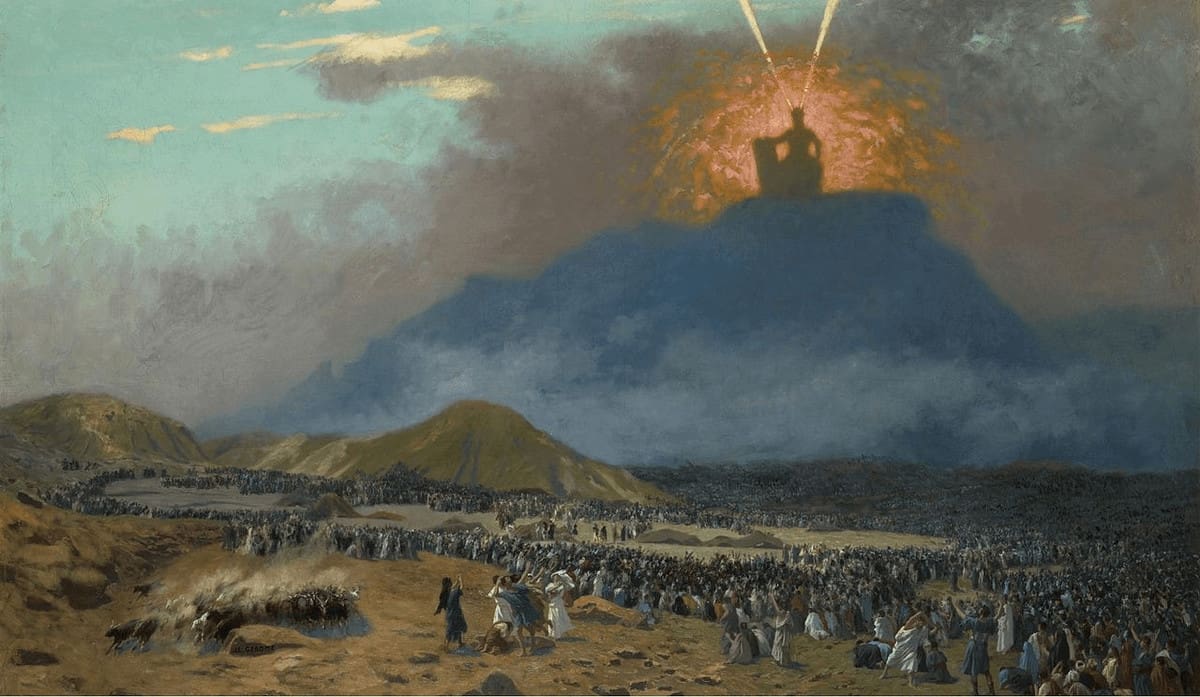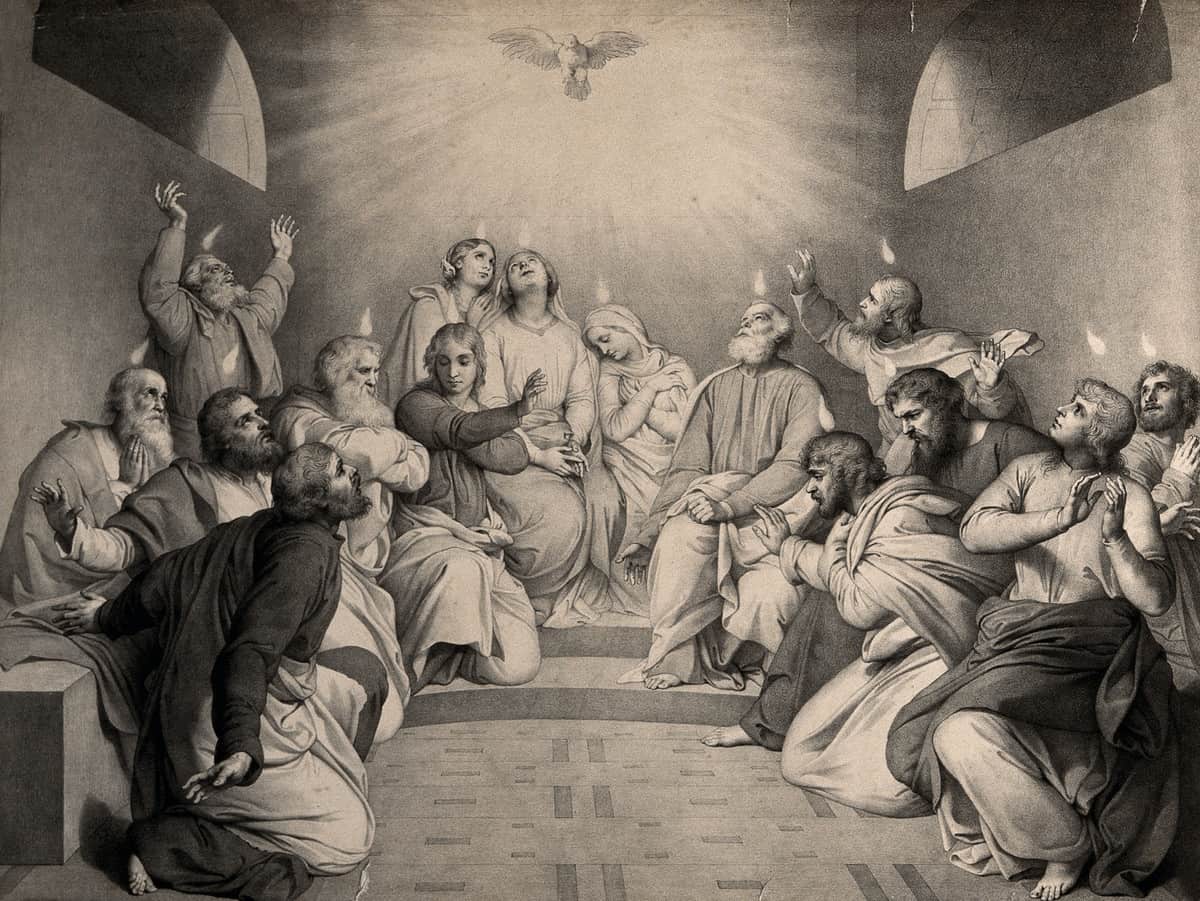What is Pentecost in the Bible? Most people associate it with the New Testament: the day God poured out his Holy Spirit on the Jerusalem church in the Upper Room, enabling his disciples to perform incredible acts—like healings, speaking in tongues, prophesying, and inspired preaching1—as told in Acts 2:1–4:
When the day of Pentecost arrived, they were all together in one place. And suddenly there came from heaven a sound like a mighty rushing wind, and it filled the entire house where they were sitting. And divided tongues as of fire appeared to them and rested on each one of them. And they were all filled with the Holy Spirit and began to speak in other tongues as the Spirit gave them utterance.
Jesus had promised his disciples a “baptism in the Holy Spirit” (Acts 1:5, 8), that he would send them a “Helper” who would “teach [them] all things” (John 14:26), and that he would not leave the disciples “as orphans” (John 14:18). That day, as about 120 disciples huddled in a room in Jerusalem, those promises were fulfilled.
However, Acts 2 was not the first celebration of Pentecost. In fact, that first Pentecost occurred on the ancient Jewish holiday known as the Feast of Weeks.
Coincidence?
Not if you understand what the Feast of Weeks was all about.
Understanding this feast and God’s initiation of it in the Old Testament helps us to comprehend the magnitude of what happened that day when the Holy Spirit descended on the disciples—the day God’s church began.
But before we head to the Old Testament to learn more about Pentecost in the Bible, let’s first unpack what a “feast” is.
- A shadow of things to come
- Pentecost in the Old Testament
- Coincidence? Or Co-incident?
- Pentecost in the Bible: foreshadowed by Joel
A shadow of things to come
God initiated these “feasts” in Leviticus 23:
Speak to the people of Israel and say to them, these are the appointed feasts of the Lord that you shall proclaim as holy convocations; they are my appointed feasts. (v. 2, emphasis added)
In Hebrew, the word for “feast” is mo’ed, which means “appointed time, place, or meeting.” (Some translations use the word “festival.”) These were seven set times throughout the year God commanded the nation of Israel to meet with him2—four in the spring and the remaining three in the fall: Sabbath, Passover, the Feast of Firstfruits, the Feast of Weeks, the Feast of Trumpets, the Day of Atonement, and the Feast of Booths (or “Tabernacles”).3
Pentecost was the last spring feast on the Hebrew calendar.
Paul referenced these feasts (festivals) in Colossians 2:16–17:
Therefore let no one pass judgment on you in questions of food and drink, or with regard to a festival or a new moon or a Sabbath. These are a shadow of the things to come, but the substance belongs to Christ. (Emphasis added)
According to Paul, these feasts are not the reality but the shadow that points to and finds its fulfillment in Christ.
Picture the shadow of a tree with clearly defined branches. The shadow only gives an idea of what the tree looks like, smells like, feels like. It’s the tree itself that has substance. The tree itself is real.

All seven feasts are like the tree’s shadow. They merely point to the reality, the “substance,” found in Christ.
With that understanding, let’s now dig into the “shadow” of the Feast of Weeks in the Old Testament and see what we can learn.
Pentecost in the Old Testament
The word “Pentecost” (from the Greek word pentēkostē, meaning “fiftieth”)4 comes from the Greek name for a harvest festival that is also known as the “Feast of Weeks.”
This unique feast occurred 7 weeks after Passover (49 days), culminating with the actual feast on day 50 (hence, the New Testament term “Pentecost”). It’s the fourth of the spring feasts that marked the end of the barley harvest and the start of the wheat harvest (usually around June). It’s also called the Day of the Firstfruits, the Feast of Harvest, or in Hebrew (and in Israel today), Shavuot (which means “weeks”).

Of the seven feasts, the Feast of Weeks is one of three that God commanded Israel to celebrate at the temple after it was established in Jerusalem (Deut 16:16–17) and so was a “pilgrimage” feast.5
In Jesus’ day, Jews who didn’t live in or near Jerusalem often had to travel long distances to keep the festival according to God’s instruction.6
The details about the Feast of Weeks are found in Leviticus 23:15–21:7
You shall count seven full weeks from the day after the Sabbath, from the day that you brought the sheaf of the wave offering. You shall count fifty days to the day after the seventh Sabbath. Then you shall present a grain offering of new grain to the Lord. You shall bring from your dwelling places two loaves of bread to be waved, made of two tenths of an ephah. They shall be of fine flour, and they shall be baked with leaven, as firstfruits to the Lord.
And you shall present with the bread seven lambs a year old without blemish, and one bull from the herd and two rams. They shall be a burnt offering to the Lord, with their grain offering and their drink offerings, a food offering with a pleasing aroma to the Lord. And you shall offer one male goat for a sin offering, and two male lambs a year old as a sacrifice of peace offerings. And the priest shall wave them with the bread of the firstfruits as a wave offering before the Lord, with the two lambs. They shall be holy to the Lord for the priest. And you shall make a proclamation on the same day. You shall hold a holy convocation. You shall not do any ordinary work. It is a statute forever in all your dwelling places throughout your generations.
Notice that God commanded the Israelites to hold this annual, one-day harvest festival “fifty days to the day after the seventh Sabbath” (v. 16; see also Exod 34:22; Lev 23:15–21; Deut 16:9–10; 2 Chr 8:13), or on day 50. Tyndale Bible Dictionary says on the Feast of Weeks, the ancient Israelites presented freewill gifts to the Lord “to reflect gratitude for his blessings, and the entire occasion was one of communal rejoicing.” In Jesus’ day, farmers would start their journeys toward Jerusalem at the Feast of Weeks to offer their firstfruit grain offerings from their harvests.8
It was a time to “recognize that they depended entirely upon God for their material prosperity.”9
The Mount Sinai connection
Though primarily a festival of thanksgiving for the firstfruits of the wheat harvest, Jews later declared the Feast of Weeks “to be the day on which God gave the law to Israel.”10
Recall that after leaving Egypt on Passover eve, the Israelites had journeyed into the Sinai desert where God gave the nation, through Moses, the Ten Commandments (as well as the entire Old Testament law). Later, Moses reminded Israel of this:
Remember the day you stood before the Lord your God at Horeb [Sinai] . . . You came near and stood at the foot of the mountain while it blazed with fire to the very heavens, with black clouds and deep darkness. Then the Lord spoke . . . He declared to you his covenant, the Ten Commandments, which he commanded you to follow and then wrote them on two stone tablets.” (Deut 4:10–13)
For Jews today, the Feast of Weeks is “the culmination of the 7 weeks (50 days) between Passover and the giving of the law.”11
And the same day Christians celebrate the birth of the church and the writing of God’s law on believer’s hearts, as prophesied by Jeremiah:
For this is the covenant that I will make with the house of Israel after those days, declares the Lord: I will put my law within them, and I will write it on their hearts. And I will be their God, and they shall be my people. (31:33)
Coincidence? Or Co-incident?
We mustn’t miss the details of what occurred that day on Mount Sinai:
On the morning of the third day there were thunders and lightnings and a thick cloud on the mountain and a very loud trumpet blast, so that all the people in the camp trembled. Then Moses brought the people out of the camp to meet God, and they took their stand at the foot of the mountain. Now Mount Sinai was wrapped in smoke because the Lord had descended on it in fire. The smoke of it went up like the smoke of a kiln, and the whole mountain trembled greatly. And as the sound of the trumpet grew louder and louder, Moses spoke, and God answered him in thunder. The Lord came down on Mount Sinai, to the top of the mountain. And the Lord called Moses to the top of the mountain, and Moses went up. (Exod 19:16–20)
Note how God appeared: in a “thick cloud” (Exod 19:9) with a “very loud trumpet blast” that “grew louder and louder” (vv. 13, 19) with “thunders and lightnings” (v. 16) and in “smoke” and “fire” (v. 18). In the book of Revelation, John tells us smoke indicates the glory (or greatness) of God (15:8), while fire is a conventional literary feature of a theophany—a visible manifestation of God12(e.g., Gen 15:17; Exod 3:2; 2 Thess 1:7–8; Zech 2:5; Isa 4:5; Heb 12:18).13
More simply, smoke and fire point to God’s presence.
Thousands of years later, as 120 men and women gathered in the Upper Room on the Feast of Weeks, the Lord once again descended in fire as all of Jerusalem celebrated and remembered the giving of the law on Mount Sinai.

Compare Exodus 19 with Acts 2:
When the day of Pentecost arrived, they were all together in one place. And suddenly there came from heaven a sound like a mighty rushing wind, and it filled the entire house where they were sitting. And divided tongues as of fire appeared to them and rested on each one of them. And they were all filled with the Holy Spirit and began to speak in other tongues as the Spirit gave them utterance. (Acts 2:1–4)
God’s presence once again descended on his people but this time with a mighty rushing wind (v. 2) and divided tongues of fire (v. 3) that indwelt the disciples, just as Jesus had promised. His Spirit would continually be present as their guide, teacher, comforter, and friend—no longer externally but in their hearts.

Pentecost in the Bible: foreshadowed by Joel
Joel was a prophet in the ninth century BC during Joash’s reign. In Joel 2:28–29, he tells of a future day when God’s Spirit would once again be with his people:
And it shall come to pass afterward, that I will pour out my Spirit on all flesh; your sons and your daughters shall prophesy, your old men shall dream dreams, and your young men shall see visions. Even on the male and female servants in those days I will pour out my Spirit.
On that first Pentecost after Jesus’ resurrection, as thousands upon thousands of Jews packed Jerusalem to celebrate the Feast of Weeks as God had commanded centuries earlier, Joel’s prophecy came to pass.
Filled with the Holy Spirit, the disciples began “speaking in other tongues as the Spirit gave them utterance” (Acts 2:4), attracting the attention of curious onlookers who wondered what was happening. When doubters said they were drunk with wine (Acts 2:12), Peter responded by saying, “This is what was spoken of by the prophet Joel”—and proceeded to give the gospel message with a call to repentance for all who had ears to hear.
Those who believed were baptized, and Acts 2:41 says “about three thousand souls” were added that day—the firstfruits of the “harvest” of believers.14
Conclusion
The “shadow” of God’s giving of the law at Mount Sinai—his perfect instruction intended to guide, teach, direct, and speak through his people Israel—was now “[written] on believer’s hearts” (Jer 31:33; see also Rom 2:15). The Old Testament celebration of the firstfruits of the agricultural harvest became a reality as the “Lord of the harvest” (Matt 9:38) began his church through the firstfruits of believers—now empowered witnesses to his life, death, and resurrection.
This is the meaning of Pentecost in the Bible, the only feast both Jews and Christians both celebrate.
And it’s just one part of the beautiful tapestry God has been weaving together since the beginning of time.
Related articles
- Palm Sunday, and Why the ‘Date’ Is So Significant
- Are the Ten Commandments Still Relevant?
- The Ascension of Christ and the Spirit of Pentecost
- The Ascension of Jesus: 5 Reasons It’s Often Neglected
Related resources
- Celebrating Jesus in the Biblical Feasts by Richard Booker
- John D. Barry, Lexham Bible Dictionary, “Pentecost” (Lexham Press, Bellingham, WA), 2016.
- John D. Barry, Lexham Bible Dictionary, “Feasts and Festivals of Israel” by John T. Swann (Lexham Press, Bellingham, WA) 2016.
- Read about all seven feasts in Leviticus 23:1–44.
- The Septuagint (the Greek translation of the Old Testament) uses the term pentēkostē for the feast of Pentecost twice, in the books of Tobit and 2 Maccabees.
- “The Hebrew word used here ‘chag’ (which may be rendered as “feast” or “festival”), refers to a pilgrimage festival. This word is used to describe the festivals of Unleavened Bread (Lev 23:6), Tabernacles (v. 39), and Weeks (Exod 34:22; Deut 16:16). In time, celebrations connected to the wandering Israelite population changed to a time that featured a settled population and a central sanctuary (temple) (compare Exod 12; 34 and Deut 16). The major festivals thus required pilgrimage (see 1 Kgs 12:26–32).” John D. Barry, Faithlife Study Bible, “Lev 23:6” (Lexham Press, Bellingham, WA), 2016.
- John D. Barry, Lexham Bible Dictionary, “Feasts and Festivals of Israel” (Lexham Press, Bellingham, WA), 2016.
- See also Exod 23:14–17 and Deut 16:16.
- John D. Barry, Lexham Bible Dictionary, “Pentecost” (Lexham Press, Bellingham, WA), 2016; (Wigoder, “Shavu’ot,” 707; Werblowsky, “Shavu’ot,” 628.
- Philip W. Comfort, Tyndale Bible Dictionary, “Pentecost” (Tyndale, 2001), 483.
- David Brickner, Christ in the Feast of Pentecost (Moody Publishing, 2008), 42.
- After the Second Temple was destroyed and Jewish people were dispersed from their land, Jews focused less on the agricultural “motif” and instead on God’s revelation of his perfect instruction at Mount Sinai. https://www.ifcj.org/learn/jewish-holidays/shavuot/what-is-shavuot-pentecost/
- Joshua R. Westbury, Lexham Figurative Language of the Bible Glossary, “List of Figurative Language Related to Fire” (Lexham Press, Bellingham, WA), 2016.
- See also Deut 4:12–33; Psa 29:7 where God’s voice is connected with fire, connecting fire with the presence of the second person of the trinity, Jesus—the word made flesh.
- We mustn’t miss the connection in Exodus 32:28, where 3,000 died for their unbelief after worshiping the golden calf.







